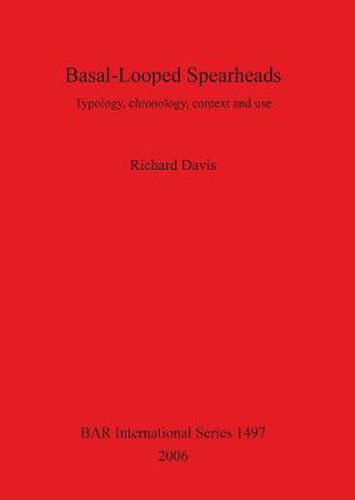Readings Newsletter
Become a Readings Member to make your shopping experience even easier.
Sign in or sign up for free!
You’re not far away from qualifying for FREE standard shipping within Australia
You’ve qualified for FREE standard shipping within Australia
The cart is loading…






This title is printed to order. This book may have been self-published. If so, we cannot guarantee the quality of the content. In the main most books will have gone through the editing process however some may not. We therefore suggest that you be aware of this before ordering this book. If in doubt check either the author or publisher’s details as we are unable to accept any returns unless they are faulty. Please contact us if you have any questions.
Basal-looped spearheads were prevalent in the British Isles during the later part of the Middle Bronze Age. Their main period of use covered the Taunton and Penard industrial phases in Britain, and the contemporary Bishopsland phase in Ireland, dating to around 1300-1000 BC. Distribution also extended to the northwestern area of Continental Europe. The diagnostic attribute of these spearheads is the loops at the base of the blade, either incorporated within the blade, or projecting below it. Ireland is likely to have been the place of origin of the category, with manufacturing taking place in Ireland, Britain and on the Continent. 551 basal-looped spearheads are included in the study’s catalogue. 54% of these come from Britain, 32% from Ireland and 14% from the Continent. A typology is developed for the category, sorting them into eight main types and establishing the chronological sequence of these types. Recovery contexts are weighted to watery locations at 80% of the total, supporting the interpretation that much of the deposition was purposeful, and represented a form of votive offering. The condition of the spearheads is analyzed, from which it can be concluded that at least two thirds had been used in some form of combat. An experimental programme was undertaken with replicas which were combat tested at the Royal Armouries, Leeds. The programme demonstrated the versatility of the basal-looped spearhead, and its overall superiority to the rapier, the main contemporary sidearm. The basal-looped spearhead may therefore be considered the primary weapon of its time in the British Isles, with use in warfare and on ceremonial occasions. Its supremacy began to be eclipsed during the Penard phase with the introduction of the early flange-hilted swords from the Continent.
$9.00 standard shipping within Australia
FREE standard shipping within Australia for orders over $100.00
Express & International shipping calculated at checkout
This title is printed to order. This book may have been self-published. If so, we cannot guarantee the quality of the content. In the main most books will have gone through the editing process however some may not. We therefore suggest that you be aware of this before ordering this book. If in doubt check either the author or publisher’s details as we are unable to accept any returns unless they are faulty. Please contact us if you have any questions.
Basal-looped spearheads were prevalent in the British Isles during the later part of the Middle Bronze Age. Their main period of use covered the Taunton and Penard industrial phases in Britain, and the contemporary Bishopsland phase in Ireland, dating to around 1300-1000 BC. Distribution also extended to the northwestern area of Continental Europe. The diagnostic attribute of these spearheads is the loops at the base of the blade, either incorporated within the blade, or projecting below it. Ireland is likely to have been the place of origin of the category, with manufacturing taking place in Ireland, Britain and on the Continent. 551 basal-looped spearheads are included in the study’s catalogue. 54% of these come from Britain, 32% from Ireland and 14% from the Continent. A typology is developed for the category, sorting them into eight main types and establishing the chronological sequence of these types. Recovery contexts are weighted to watery locations at 80% of the total, supporting the interpretation that much of the deposition was purposeful, and represented a form of votive offering. The condition of the spearheads is analyzed, from which it can be concluded that at least two thirds had been used in some form of combat. An experimental programme was undertaken with replicas which were combat tested at the Royal Armouries, Leeds. The programme demonstrated the versatility of the basal-looped spearhead, and its overall superiority to the rapier, the main contemporary sidearm. The basal-looped spearhead may therefore be considered the primary weapon of its time in the British Isles, with use in warfare and on ceremonial occasions. Its supremacy began to be eclipsed during the Penard phase with the introduction of the early flange-hilted swords from the Continent.